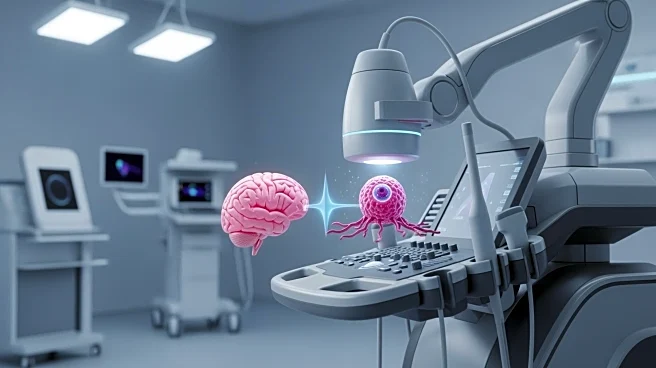What's Happening?
Recent advancements in focused ultrasound technology are showing promise in treating conditions such as Alzheimer's disease and cancer. This technique involves concentrating sound energy into a specific volume, which can be fine-tuned to target various
medical conditions. Historically, focused ultrasound has been used to heat and destroy brain tissue, similar to how sunlight can be concentrated with a magnifying glass. Despite early challenges, such as the absorption of ultrasound energy by the skull, researchers have made significant progress by integrating ultrasound transducers with imaging technology. This has allowed for more precise targeting of affected areas. Clinical trials are underway to explore the use of focused ultrasound in improving drug delivery to the brain, stimulating immune responses against cancer, and treating rare diseases of the central nervous system.
Why It's Important?
The development of focused ultrasound technology has the potential to revolutionize treatment for several debilitating conditions. By temporarily opening the blood-brain barrier, focused ultrasound can facilitate the delivery of drugs directly to the brain, which is crucial for treating diseases like glioblastoma and Alzheimer's. Additionally, this technology can enhance cancer immunotherapy by helping the immune system recognize and destroy cancer cells more effectively. The University of Virginia has established a focused ultrasound immuno-oncology center to further research in this area. The ability to treat rare diseases, such as cerebral cavernous malformation, with focused ultrasound also presents a significant advancement, offering hope for conditions that currently have limited treatment options.
What's Next?
Ongoing clinical trials are testing the efficacy of focused ultrasound in delivering drugs to the brain and treating advanced melanoma with a combination of ultrasound and immunotherapy. Researchers are also exploring the use of focused ultrasound to stabilize cerebral cavernous malformations, potentially offering a non-invasive treatment option for this rare condition. As research progresses, focused ultrasound could become a standard treatment for a variety of diseases, expanding its application beyond the most prevalent conditions to include rare diseases. Continued advancements in imaging technology and acoustic physics will likely enhance the precision and effectiveness of this treatment modality.
Beyond the Headlines
Focused ultrasound technology not only offers a new approach to treating diseases but also raises ethical and regulatory considerations. The ability to manipulate the blood-brain barrier and stimulate immune responses requires careful oversight to ensure patient safety and efficacy. As this technology becomes more widespread, it may also influence healthcare policy and funding priorities, particularly in the realm of rare disease research. The integration of focused ultrasound into standard medical practice could lead to shifts in treatment paradigms, emphasizing non-invasive techniques and personalized medicine.













